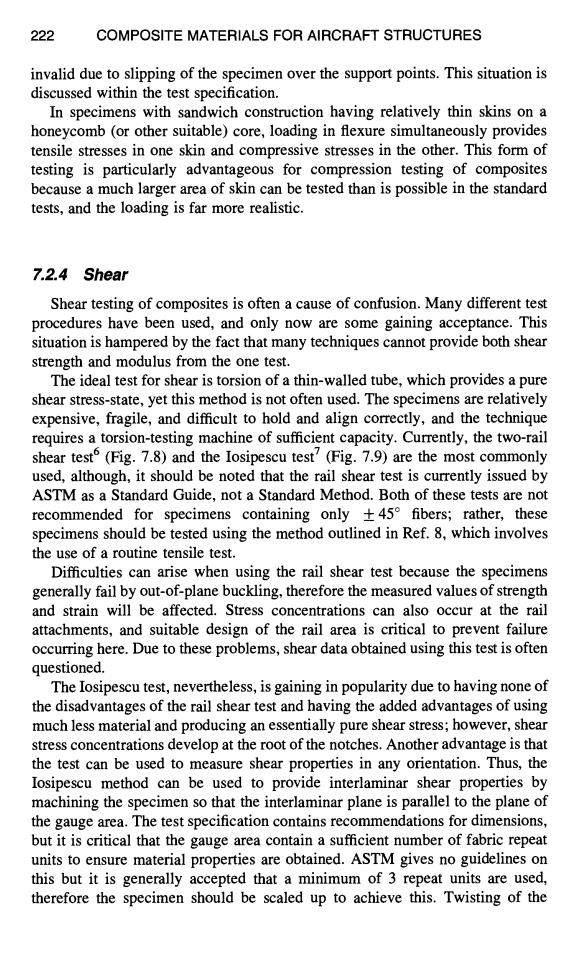正在加载图片...

222 COMPOSITE MATERIALS FOR AIRCRAFT STRUCTURES invalid due to slipping of the specimen over the support points.This situation is discussed within the test specification. In specimens with sandwich construction having relatively thin skins on a honeycomb (or other suitable)core,loading in flexure simultaneously provides tensile stresses in one skin and compressive stresses in the other.This form of testing is particularly advantageous for compression testing of composites because a much larger area of skin can be tested than is possible in the standard tests,and the loading is far more realistic. 7.2.4 Shear Shear testing of composites is often a cause of confusion.Many different test procedures have been used,and only now are some gaining acceptance.This situation is hampered by the fact that many techniques cannot provide both shear strength and modulus from the one test. The ideal test for shear is torsion of a thin-walled tube,which provides a pure shear stress-state,yet this method is not often used.The specimens are relatively expensive,fragile,and difficult to hold and align correctly,and the technique requires a torsion-testing machine of sufficient capacity.Currently,the two-rail shear test(Fig.7.8)and the Iosipescu test'(Fig.7.9)are the most commonly used,although,it should be noted that the rail shear test is currently issued by ASTM as a Standard Guide,not a Standard Method.Both of these tests are not recommended for specimens containing only +45 fibers;rather,these specimens should be tested using the method outlined in Ref.8,which involves the use of a routine tensile test. Difficulties can arise when using the rail shear test because the specimens generally fail by out-of-plane buckling,therefore the measured values of strength and strain will be affected.Stress concentrations can also occur at the rail attachments,and suitable design of the rail area is critical to prevent failure occurring here.Due to these problems,shear data obtained using this test is often questioned. The losipescu test,nevertheless,is gaining in popularity due to having none of the disadvantages of the rail shear test and having the added advantages of using much less material and producing an essentially pure shear stress;however,shear stress concentrations develop at the root of the notches.Another advantage is that the test can be used to measure shear properties in any orientation.Thus,the losipescu method can be used to provide interlaminar shear properties by machining the specimen so that the interlaminar plane is parallel to the plane of the gauge area.The test specification contains recommendations for dimensions, but it is critical that the gauge area contain a sufficient number of fabric repeat units to ensure material properties are obtained.ASTM gives no guidelines on this but it is generally accepted that a minimum of 3 repeat units are used, therefore the specimen should be scaled up to achieve this.Twisting of the222 COMPOSITE MATERIALS FOR AIRCRAFT STRUCTURES invalid due to slipping of the specimen over the support points. This situation is discussed within the test specification. In specimens with sandwich construction having relatively thin skins on a honeycomb (or other suitable) core, loading in flexure simultaneously provides tensile stresses in one skin and compressive stresses in the other. This form of testing is particularly advantageous for compression testing of composites because a much larger area of skin can be tested than is possible in the standard tests, and the loading is far more realistic. 7.2.4 Shear Shear testing of composites is often a cause of confusion. Many different test procedures have been used, and only now are some gaining acceptance. This situation is hampered by the fact that many techniques cannot provide both shear strength and modulus from the one test. The ideal test for shear is torsion of a thin-walled tube, which provides a pure shear stress-state, yet this method is not often used. The specimens are relatively expensive, fragile, and difficult to hold and align correctly, and the technique requires a torsion-testing machine of sufficient capacity. Currently, the two-rail shear test 6 (Fig. 7.8) and the Iosipescu test 7 (Fig. 7.9) are the most commonly used, although, it should be noted that the rail shear test is currently issued by ASTM as a Standard Guide, not a Standard Method. Both of these tests are not recommended for specimens containing only +45 ° fibers; rather, these specimens should be tested using the method outlined in Ref. 8, which involves the use of a routine tensile test. Difficulties can arise when using the rail shear test because the specimens generally fail by out-of-plane buckling, therefore the measured values of strength and strain will be affected. Stress concentrations can also occur at the rail attachments, and suitable design of the rail area is critical to prevent failure occurring here. Due to these problems, shear data obtained using this test is often questioned. The Iosipescu test, nevertheless, is gaining in popularity due to having none of the disadvantages of the rail shear test and having the added advantages of using much less material and producing an essentially pure shear stress; however, shear stress concentrations develop at the root of the notches. Another advantage is that the test can be used to measure shear properties in any orientation. Thus, the Iosipescu method can be used to provide interlaminar shear properties by machining the specimen so that the interlaminar plane is parallel to the plane of the gauge area. The test specification contains recommendations for dimensions, but it is critical that the gauge area contain a sufficient number of fabric repeat units to ensure material properties are obtained. ASTM gives no guidelines on this but it is generally accepted that a minimum of 3 repeat units are used, therefore the specimen should be scaled up to achieve this. Twisting of the